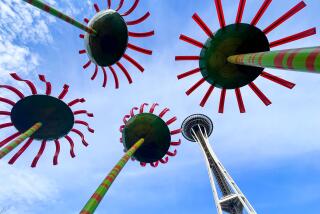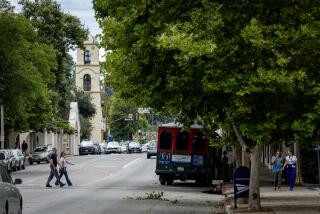Gawking Follows the Shaking
SEATTLE — They came to historic Pioneer Square just to see for themselves. They had watched television news accounts all day and still they just had to see it:
The chunks of brick in piles on the ground; the shattered glass sprinkling the cobblestones; the red and yellow tape keeping these Seattle residents from entering their favorite bars and shuttering favorite cafes such as Torrefazione Italia and even--heaven forbid--Starbucks.
And so they came, armed with cameras, children and fond memories of places such as the Fenix Underground, a Pioneer Square fixture.
“I just had to come down and see what was going on,” said 33-year-old Dave Evans as he stood outside the nightclub bundled in a black wool coat. “I called my mom in New York and she said: ‘I hear the whole city’s collapsing.’ I thought it was a much greater catastrophe . . . so I had to come see it.”
Still, for the fans of Fenix it was. The brick building--which like most in the square was built after the great fire in Seattle in the late 1800s--looked as if a can opener sliced parts of its top off. Two cars, whose owners must have felt pretty lucky finding prime parking in downtown Seattle when they left them Wednesday morning, could not have driven them away; they were surrounded with bricks and chunks of concrete.
Chris Anderson and Graham Jordan came down to Pioneer Square on Wednesday night to take some photos of their favorite haunts. “This is one of the best bar districts in town,” Anderson, 30, said.
Added Jordan: “This earthquake was bigger than we thought. We’re surprised by all of this.”
They were really surprised at F.X. McRory’s Steak Chop and Oyster House, where dozens of liquor bottles stand on glass shelves. Only one fell. And it was empty, said John Munn, the bartender who was on duty Wednesday.
“It wasn’t so bad,” Munn said, adding that the building was erected in 1910 and used to be a pharmaceutical warehouse.
The irony, these Seattle residents noted, was that some of the city’s oldest buildings fared quite well here in Pioneer Square, while others crumbled. These buildings were constructed on landfill.
“It could have been much, much worse,” said Shannon Young, 26. “They’ve been scaring us for years about some monster earthquake. If this is the monster, I’ll take it.”
But at Agate Designs, a Pioneer Square gem and mineral shop, a weary Terry Derosier spent eight hours Wednesday sweeping up shards of glass, trying to salvage pieces of amethyst. He estimates his shop lost about $25,000 worth of merchandise.
And this was the second night in a row that Derosier had stayed late at his shop. On Tuesday, Mardi Gras revelers turned quaint Pioneer Square into a riot zone.
“We’ve been double-whammied,” Derosier said. “There are a lot of broken windows, and you can’t tell when it was from--the rioters or the earthquake.”
At the Paper Cat rubber stamp shop, the floor was covered with stamps, ink pads and notebooks. The glass door was shattered. Windows along 2nd Avenue and Jackson Street were boarded. Police and traffic officers circled the area. Television reporters did stand-ups in front of piles of concrete and brick.
“I’m just blown away by it,” said Lance King, who came to survey the damage with his wife and her mother. “But I think we’re pretty lucky considering the magnitude of the earthquake.”
Perhaps even more philosophical was a Seattle traffic officer who kept things moving around a building with structural damage.
“It’s all part of the ballgame,” he said. “Act of God, natural disaster. It’s just part of life.”
More to Read
Sign up for Essential California
The most important California stories and recommendations in your inbox every morning.
You may occasionally receive promotional content from the Los Angeles Times.










